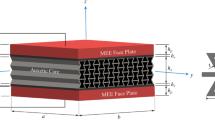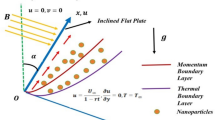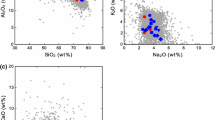Abstract
The thermal diffusivity of quartz, orthoclase, and sanidine was measured in different directions by a transient method, to determine the second-rank tensor of thermal transport properties as a function of temperature up to 800 °C. Thermal diffusivity of phonons is described as D=1/3 v l, where v is the phonon velocity and l the mean free path length of phonons. In quartz the thermal diffusivity at room temperature is 3.60 mm2 s−1 in [1 0 0] and 7.00 mm2 s−1 in [0 0 1] direction. A 1/T dependency of thermal diffusivity is observed for both directions up to 550 °C with a pronounced anisotropy (A=62%; A=(D max − D min)/D average), which decreases with increasing temperature. Close to the α–β-phase transition, we observed a minimum in thermal diffusivity and a negligible anisotropy. Up to 573 °C the maximam of thermal diffusivity, average phonon velocity, and mean free path length are observed in [0 0 1] direction. However, above the temperature of phase transition the maximum values of the properties are observed in [1 0 0] direction. The observed behavior is explained by a model which interrelates velocity and mean free path length of phonons. A further contribution to the thermal diffusivity behavior is related to the higher symmetry of β-quartz, resulting in a reduced phonon–phonon-scattering probability. At ambient temperature, orthoclase and sanidine show similar values of thermal diffusivities (≈1 mm2 s−1) and a temperature-independent anisotropy behavior between 22 and 350 °C of ≈30%. For both feldspars a small 1/T temperature dependence of thermal diffusivity up to 350 °C is observed. The transparent sanidine in gemstone quality shows a strong increase in thermal diffusivity above 350 °C proportional to T 3. The contribution of the radiative heat-transfer mechanism leads to values more than two times higher in sanidine than in a milky-cloudy orthoclase at 800 °C. For the feldspars the mean free path length of phonons shows a small temperature dependence on reaching ≈0.4–0.5 nm at 800 °C and thus already in the range of the interatomic distances of ≈0.27–0.34 nm. The pronounced difference in thermal diffusivity behavior between quartz and orthoclase, which have a related tectosilicate structure, is connected to additional cations of K, Na, and Al within the feldspar structure.
Similar content being viewed by others
Author information
Authors and Affiliations
Additional information
Received: 13 July 2001 / Accepted: 20 July 2002
Acknowledgements We are indebted to J. Arndt and W. Heinrich for their support. The constructive and helpful review by A. Hofmeister is gratefully acknowledged. We express our gratitude to U. Seipold and M. Koch-Müller for helpful and stimulating discussions, D. Bruhn for critically reading the manuscript, and G. Berger and M. Kreplin for sample preparation. This work was sponsored by the Deutsche Forschungsgemeinschaft.
Rights and permissions
About this article
Cite this article
Höfer, M., R., F. Heat transfer in quartz, orthoclase, and sanidine at elevated temperature. Phys Chem Min 29, 571–584 (2002). https://doi.org/10.1007/s00269-002-0277-z
Issue Date:
DOI: https://doi.org/10.1007/s00269-002-0277-z




